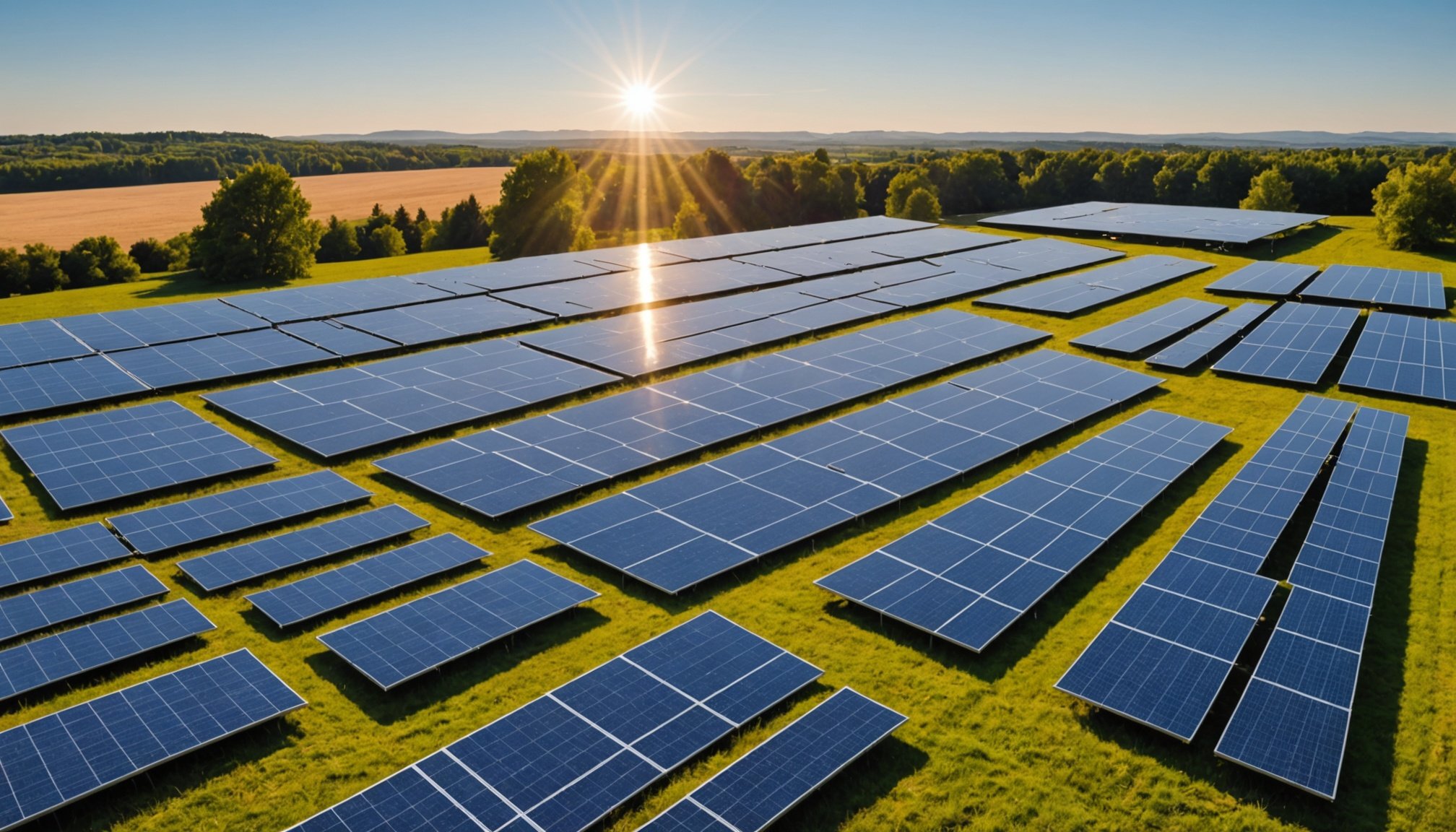Overview of Organic Photovoltaics (OPV) Technology
Organic photovoltaics (OPV) represent a cutting-edge innovation in the realm of solar energy advancements. These devices are created using organic materials, fundamentally differing from traditional silicon-based solar cells. The foundational principle behind OPV technology involves the absorption of light by organic materials, generating excitons, which are then separated into charges for electricity production.
When comparing OPV with conventional solar technologies, several distinctions emerge. Traditional solar panels usually require rigid, heavy materials like silicon, whereas OPVs are made from flexible, lightweight organic compounds. This flexibility allows OPVs to be utilized in diverse applications, from building-integrated photovoltaics to portable solar chargers. Additionally, OPV manufacturing processes are considered more environmentally friendly, as they often involve lower temperatures and less energy consumption.
Have you seen this : Exploring the Impact of AI-Powered CCTV on Crime Reduction in Vulnerable Areas
In terms of global market trends, OPV technology is gradually gaining traction. Investors and developers are increasingly drawn to its potential for low-cost production and unique applications. However, challenges such as achieving higher efficiency and durability continue to inspire research and development activities to make organic photovoltaics a more formidable player in the solar energy sector. As advancements continue, OPVs hold promise for transforming how we harness solar power.
Applications of OPV in Building Integration
Building-integrated photovoltaics (BIPV) is transforming solar architecture with innovative applications of organic photovoltaic (OPV) technology. These advancements have allowed architects to integrate solar power seamlessly into building structures, paving the way for greener, more sustainable urban environments.
Also to discover : Maximize your reach with quick video promos online
OPV applications are versatile and visually appealing, which is a significant advantage for modern architectural designs. The flexibility of OPV films enables them to conform to various surfaces, making them ideal for applications on windows, façades, and roofs. Unlike traditional solar panels, OPVs can also be designed in a variety of colours and transparencies, enhancing aesthetics while generating renewable energy.
Integrating OPVs within building structures offers numerous benefits, including reduced energy costs and an enhanced building sustainability profile. By generating solar energy directly onsite, buildings can reduce their reliance on conventional energy sources, contributing to lower carbon emissions.
Successful case studies demonstrate the practicality and benefits of OPV integration. For instance, in a project in Germany, OPV technology was utilized to create an elegant, energy-efficient building façade. Such examples highlight how OPVs can blend function with form, leading to energy-efficient architectural designs. With ongoing advancements, OPV is poised to become a staple in sustainable building practices, offering a practical and aesthetic solution for urban energy needs.
Recent Innovations in OPV Technology
Organic Photovoltaics (OPV) are gaining momentum, thanks to groundbreaking research and exciting advancements. This has sparked a flurry of activity and innovation within the realm of solar technology advancements. These strides are anticipated to broaden the application of OPV in various sectors.
In the quest for enhanced efficiency, researchers have delved into innovative materials and methods. The use of new photovoltaic research techniques has brought about materials with better light absorption and charge mobility. These developments stand to significantly boost the overall performance of OPV systems, offering efficient and cost-effective solar energy solutions.
When it comes to key players in the OPV landscape, several institutes and companies are at the forefront. Leading academic institutions are conducting extensive studies, while tech companies are heavily investing in OPV innovations seeking to transform solar energy markets. Their work is driving the transition towards sustainable energy solutions that rely less on traditional silicon-based solar cells.
As OPV technology matures, its potential applications continue to expand, paving the way for innovative uses in low-power electronic devices and portable solutions. These innovations are not just technologically savvy, but also meaningful advancements towards more widespread adoption of renewable energy sources.
Environmental Impacts of OPV
Organic Photovoltaics (OPV) hold tremendous potential in contributing to sustainability efforts and enhancing renewable energy impacts. When evaluating the carbon footprint, OPVs are distinct in their environmental benefits compared to traditional solar panels. Unlike conventional panels, the manufacturing process of OPVs tends to consume fewer resources, leading to reduced carbon emissions.
OPV’s lightweight and flexible nature allows for integration into various surfaces, playing a crucial role in promoting sustainable building practices. These features enable buildings to incorporate renewable energy without the need for significant structural modifications. The adaptability of OPVs can seamlessly blend into the architecture, further boosting sustainability by decreasing energy dependency from non-renewable sources.
In assessing the long-term environmental benefits, OPVs offer substantial promise. Their potential for reducing pollution and greenhouse gases is notable. By encouraging the adoption of OPV technology, societies can achieve substantial strides in renewable energy impacts, aiding global efforts to combat climate change. As technology advances, OPVs might become even more efficient and affordable, ensuring that the environmental benefits continue to grow, making them a viable component of future energy solutions. The progress in OPV technology represents a significant step towards more sustainable, environmentally friendly energy practices.
Economic Viability and Market Potential
Economic feasibility is a critical consideration for the integration of Organic Photovoltaics (OPV) in building projects. OPVs offer a unique advantage due to their lightweight and flexible properties, which can lead to reduced installation costs compared to traditional solar panels. Their ability to be seamlessly integrated into various surfaces, such as facades and windows, enhances their cost-effectiveness, making them an appealing option for developers looking to enhance energy efficiency in a sustainable manner.
A comprehensive market analysis reveals a positive outlook for OPV. Trends in renewable energy investments are increasingly leaning towards innovative technologies like OPV due to their potential to revolutionize the solar industry. With an increasing focus on sustainable architecture, investment in OPV is gathering momentum, supported by both private and government funding. Notable financial institutions are identifying OPV as a promising sector for investment, indicating robust future growth potential.
Predictions for market growth are optimistic, with adoption rates expected to climb as the technology matures and production costs decrease. The synergy between OPV’s economic feasibility and the ongoing growth in renewable energy investments positions OPV to be a significant player in the future energy market landscape. This favorable environment for OPV suggests promising investment opportunities and substantial long-term benefits.
Challenges and Barriers to OPV Integration
Organic Photovoltaics (OPV) technology offers promising potential, yet it faces several integration challenges. Primarily, technical issues such as efficiency, stability, and production cost impede its commercial viability. These OPV limitations affect how effectively the technology can be scaled for industrial use. Regulatory hurdles also pose significant barriers. Stricter industry standards and certification processes can slow development and market entry for new OPV products.
Beyond technical and regulatory concerns, public perception plays a crucial role in OPV’s market acceptance. Consumers may harbour doubts regarding the performance and reliability of OPV compared to traditional photovoltaics. Efforts to enhance transparency and educate the public about OPV’s benefits can significantly shift attitudes positively.
Adopting tailored strategies is essential for overcoming these barriers. Fostering collaborations between industry players and researchers can drive innovation and address technical challenges more effectively. Encouraging policy-makers to support regulatory reform and investment can also facilitate smoother industry transitions. Moreover, by promoting the tangible benefits of OPV, such as its environmental advantages, stakeholders can build more confidence among potential consumers and investors. Overall, a multifaceted approach combining technological, regulatory, and social strategies is necessary to advance the successful integration of OPV.
Expert Opinions and Future Trends
In the evolving landscape of solar technology, expert analysis offers vital insights into the future of Organic Photovoltaics (OPV). According to industry insights, OPVs are seen as a game-changer for solar building integration, with their lightweight and flexible properties allowing for creative architectural solutions. Researchers project the future of OPV to be promising, citing enhancements in efficiency and manufacturing techniques as key developments.
Industry leaders emphasize that the adaptability of OPV in urban settings is a significant asset. Unlike traditional solar panels, OPVs can be integrated into building fabrics, offering aesthetic advantages without sacrificing performance. Experts predict that this will lead to increased adoption in both residential and commercial sectors.
As the energy landscape shifts towards sustainability, the future of OPV aligns with broader energy ecosystem trends. OPVs hold potential not only in reducing carbon footprints but also in supporting decentralised energy models. This vision aligns with global sustainability goals, as OPVs could contribute to local energy generation, reducing reliance on grid systems.
The consensus among experts highlights OPV’s role as pivotal in the transition towards cleaner, more sustainable energy solutions, making it a focal point in discussions of future solar technologies.











